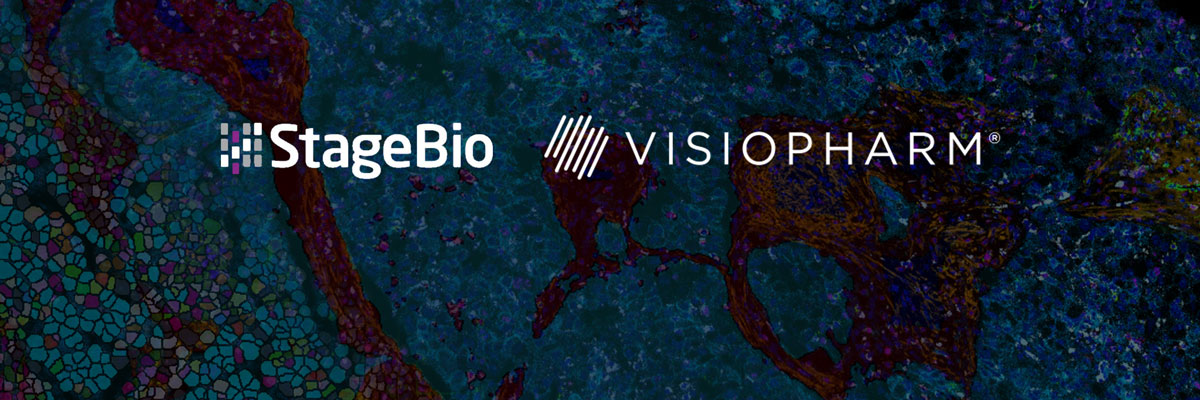Today, we are excited to bring you an in-depth conversation with StageBio, a leading CRO based in Virginia, US, that has embraced Visiopharm software as its primary image analysis platform. StageBio provides GLP-compliant research, preclinical and clinical histology, pathology, and specimen archiving services for the biopharmaceutical, medical device, and contract research industries.
Join us in this dialogue with Derick Vollmer, Digital Pathology Manager at StageBio, and discover the key reasons behind StageBio’s adoption of Visiopharm software, the challenges they had with previous solutions, and unique use cases that streamlined their operations and boosted client collaborations.

Derick Vollmer has been working in Imaging and Image Analysis at StageBio (including the prior legacy company) for over 10 years, starting as imaging specialist, then morphometrist for many years, and now as Manager of Digital Pathology. In this role, he is focused on StageBio’s Digital Pathology initiatives while still performing various imaging and image analysis tasks alongside their growing team.
Visiopharm: Welcome, Derick. Can you tell us about StageBio, your services, and how you differentiate yourselves from other CROs?
Derick Vollmer: Absolutely. At our core, StageBio is a CRO with multiple sites in the US and one in Germany, and as we expanded, we’ve incorporated a lot of specialized services. These include a medical device team, histology labs, pathology, neurology, molecular departments, toxpath labs, and archival services. Our key strength is, that we have a lot of specialized and experienced resources under the StageBio umbrella. As a result, we’re equipped to offer everything from standard histology lab work to advanced IHC or molecular work. On the digital pathology front, where I’m deeply involved, we can provide diverse imaging capabilities, including slide scanning, specialty scanners, and micro-CT. We operate internationally with clients from all over the world, which is working nicely, since we host all digital slides and results in the cloud.
Currently, Visiopharm serves as our primary analysis package. While in the past we have utilized other tools, we have found Visiopharm to be more suited to our evolving needs.
Visiopharm: What led you to search for a solution like Visiopharm?
Derick Vollmer: When the new groups merged into StageBio, the digital pathology team was suddenly presented with an influx of new types of work that required innovative solutions. One prominent task that comes to mind is the multiplex co-localization analysis on an immunofluorescence slide. It was a macrophage M1/M2 identification analysis. Although we had conducted these stains successfully, we hadn’t performed such an analysis before. In the beginning, we were exploring the tools we had at our disposal, since at that time, we didn’t have access to Visiopharm. We did experiment with other software, which simply did not meet our requirements. It felt like we were pushing these tools to their limits without achieving our desired outcomes. So we reached out to our new team in Freiburg, Germany, who were already using Visiopharm and discovered they were developing an APP specifically for M1/M2 analysis. With their foundational work and significant contributions from the US-based Visiopharm support team, we tailored the analysis further. The combined efforts resulted in the successful M1/M2 macrophage co-localization analysis.
This project showed us, that Visiopharm is an excellent piece of software for remote work and cross-site collaboration. Its capacity for co-development across diverse teams and the exceptional support we received from the Visiopharm technical team were invaluable. Their responsiveness to our inquiries has always been prompt, aiding us in designing and tweaking apps for specific analytical needs.
We were previously also using different software, including freeware and although they remain useful for certain tasks, they are complicated. When we tested different software, none seemed to completely align with our needs. Many excelled in one area but fell short in another, they seemed very specialized in one type of thing. Visiopharm’s flexibility, especially with its AI and deep learning tools, has proven incredibly helpful for us. Visiopharm not only saves time in analysis, it’s also more intuitive to use, it’s flexible and easier to train other users. While the software is comprehensive with numerous features – many of which we were initially unaware of -, the resources available on the Visiopharm website, especially the training videos, have been incredibly helpful, and of course, reaching out to the team for questions.
Today, we continue to explore new analyses, especially at our Marlborough, MA site. With each new challenge, our proficiency with the software grows. Given the diversity of our company and the wide range of specialized fields, the software’s flexibility is precisely what we need. It is an incredibly productive software to meet any of the needs that we came across to this point.
“Visiopharm’s flexibility, especially with its AI and deep learning tools, has proven incredibly helpful for us. Visiopharm not only saves time in analysis, it’s also more intuitive to use, it’s flexible and easier to train other users.”

Visiopharm: Do you recall specific capabilities you were missing in your previous solutions, limiting your analysis potential?
Derick Vollmer: Certainly. Deep learning was one of the most significant features and a key selling point when we initially considered Visiopharm. Let me give you an example: On the medical device side, we often work with bone studies, including dental and femoral defects. Our objective in these studies is to observe new bone growth in response to the implant material or treatment within a particular region of interest. Previously, the software tools we had access to, couldn’t handle the variability in the morphology of bone growth. Their color-based tissue detection approach often led to inaccuracies, requiring many hours of manual adjustments. Analyzing elements such as residual implants within these defects became increasingly complex, particularly with those typical histological artifacts. We’ve always emphasized accuracy in our work, often taking extra time to achieve the most precise results. When it comes to the bone growth analysis, the Visiopharm’s deep learning AI has been a fantastic resource. We trained models on new bone growth and this has proven incredibly efficient in capturing detailed bone analysis. In essence, the deep learning capabilities of Visiopharm have significantly improved our analysis process compared to tools that only offer color segmentation.
Furthermore, we needed a flexible software solution tailored to our regular tasks, such as the bone defect analysis and the Multiplex analysis, among others. But with our business evolving, we also wanted a solution that could adapt to new challenges.
For instance, we also conduct numerous ocular studies, especially retinal cell layer analysis, so we needed software that could distinctly recognize and analyze them. With the help of deep learning, we trained a system to identify these layers swiftly and effectively. Then, by applying this trained model, we could isolate particular areas of an ocular section and perform a better, more focused analysis. This showcases the adaptability and precision Visiopharm offers.
Before this, we manually outlined these regions, a tedious process. We used Photoshop for image masking, a method that consumed a lot of time and often involved pathologists to determine the regions of interest. In conclusion, Visiopharm not only optimizes the time of analysts but also significantly reduces the workload for pathologists, as it allows team members to focus on other critical tasks.
So, in essence, it’s the software’s flexibility that not only meets our diverse needs but also saves us time.
“When it comes to the bone growth analysis, the Visiopharm’s deep learning AI has been a fantastic resource.”

Visiopharm: Could you share some insights into how the software has added value to your business and your customers?
Derick Vollmer: Much of the value comes from the software’s flexibility. Here’s an example: Last week, a client approached us with just a histology request, specifically for pathologist evaluation. The slides they provided had a multiplex chromogenic stain, which is still rather rare. After the initial evaluation, both our pathologist and the client felt the performed standard assessment did not fully meet their needs. They wondered if a more precise, quantitative analysis could determine the cell count in the tissue.
My answer was: “Yes, we can do that”. I hadn’t done this before and I hadn’t even seen the slides yet, but I have a lot of faith in Visiopharm’s ability to distinguish unique stains. So that’s part of the exciting thing about using Visiopharm. It allows us to explore beyond the initial request, to enhance the customer’s research and its results. It has added value to our business and to our customers.
Our approach is collaborative. Instead of merely executing a client’s request and returning the data, we actively engage with them, exploring how we can further enrich their findings. We tap into our expertise, propose potential enhancements, and experiment with the resources we have. If our investigations show promise, we’ll suggest an expanded scope of work. Many of our clients are receptive to this proactive approach, pushing us to help them push their research further as well. That’s how it adds value in all cases around the board.
“So that’s part of the exciting thing about using Visiopharm. It allows us to explore beyond the initial request, to enhance the customer’s research and its results. It has added value to our business and to our customers.”

Accurate and flexible tissue research requires the right tools.
StageBio’s decision to integrate Visiopharm software into its workflow has proved to bring multiple benefits to the CRO and its clients, allowing them to get more and better research done:
- AI deep learning has transformed how the CRO handles routine tasks, allowing for enhanced precision and efficiency.
- The intuitive interface of the software and the excellent support team facilitate training new users and developing new algorithms.
- The flexibility to solve a broad range of tasks and thus enabling more in-depth and focused analyses, has added extra value to the CRO’s offers and to their customers’ research.
Curious to hear more about StageBio services? Check out their website.
If you would like to hear more about Visiopharm’s image analysis software, contact us here.
 Visiopharm
Categories: Blog
Visiopharm
Categories: Blog
